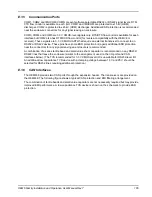
OEM6 Family Installation and Operation User Manual Rev 7
169
Figure 85: Example - Ethernet Reference Schematic
Care must be taken to provide 100
Ω
±10% differential pairs over unbroken reference (ground) planes up
to the pins on the Ethernet connector.
The Ethernet magnetics (inside the Ethernet jack on the part shown) provide high voltage isolation and
protection components for differential mode transients. ESD protection components must be placed near
the connector pins.
The spacing between receive and transmit pairs should be at least 3-4 times the width of each differential
pair (both traces plus the separation distance) to minimize crosstalk. More than two layer changes should
be avoided (single layer routing is best) and care must be taken to ensure reference planes do not
change when changing layers. If in doubt, contact your PCB vendor for appropriate dimensions for the
differential pairs.
Alternately, discrete Ethernet magnetics may be used. Ensure that the Ethernet magnetics selected meet
the specifications in the table below. Ensure the magnetics are no more than 15 cm (6 inches) from the
OEM638 expansion connector (the shorter the better). A guide to using discrete magnetics is contained
in the OEM628 Technical Reference Section of this manual.
The OEM638 Ethernet LED control lines may sink current directly from an LED (with an appropriate
current-limiting resistor). The 3.3 V supply used to bias the Ethernet magnetics must not be used to drive
the LEDs. The LED drive pins are 3.3 V tolerant only.
The following table gives recommended Ethernet transformer characteristics:







































